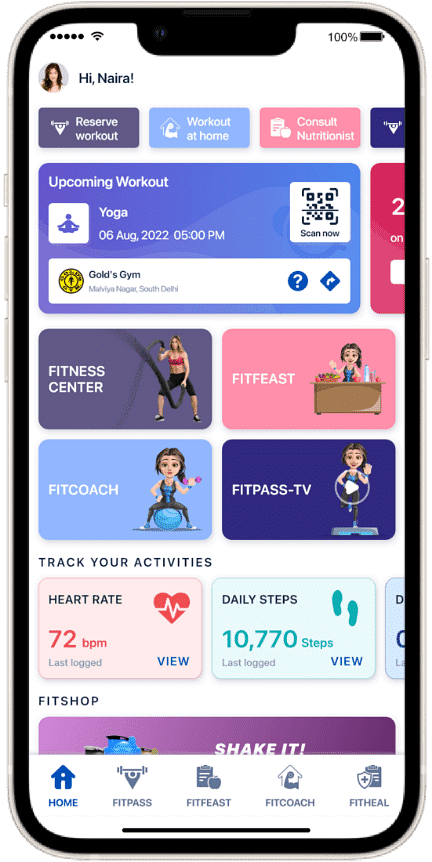7 Easy Ways To Reduce Thigh Fat
Table of Contents
Let us begin by addressing the elephant in the room – there is no single way or strategy to reduce thigh fat. You lose fat in the entire body or you don’t; it’s all or nothing. The good news is that you make certain changes in your diet and exercise to regret that stubborn thigh fat. Exercising regularly as well as eating healthy is the best way to cut down thigh fat. The body cannot differentiate between the parts of the body where the fat is burned. There’s fat all over the body and when you change your lifestyle it diminishes from every part, especially if you indulge in cardio workouts.
Want to try new workout routines that help you lose weight? Try FITPASS - a membership to an integrated network of gyms and fitness studios. Choose everything about your fitness routine and lose weight on your terms.
How to Reduce Thigh Fat

The benefits of coffee are much more than waking you up; its mild diuretic effect stimulates the metabolism and assists the body in burning fat. Drinking coffee before a workout gives you enough energy for it. Though there’s a downside though – too much coffee can upset your system. It can cause untimely cravings leading to late-night overeating in addition to possibly disrupting your sleep cycle. Too much caffeine can make feel not good generally. Drink no more than 2-3 cups of coffee a day.

The body retains excess water if you consume excessive amounts of salt, which leads to bloating. This can affect the entire body including hips and thighs. Foods naturally contain salt and when you eat more, the body stores the water instead of the kidneys filtering it out. Reducing your salt intake gives quick discernable results. You’ll be able to fit into your clothes within a few days. Studies suggest that the majority of us get much more than the required amount of sodium (1,500 MG - 2,300 MG). Therefore, cut down on sodium-packed foods like canned & processed items, sauces, soups, etc.

This might sound ironic after the previous point, but there’s a reason behind it. The body retains water if you don’t drink enough, which is why you should keep yourself hydrated. The idea is to allow the body to flush out extra water instead of cutting down intake. Drinking enough water flushes out toxins, extra salt, and excess fluids from the body. More importantly, keeping yourself hydrated curbs hunger, whereas dehydration increases hunger. Drink 2-3 liters of water each day without fail and more if the weather’s hot or you’re working out.

The body needs electrolytes to function properly. You must have heard about sports drinks that contain electrolytes. But the body needs calcium, magnesium, and potassium, which are already found in foods in our daily diets.
Potassium competes with salt. Eating potassium-rich foods reduce salt retention and maintain liquid levels in the body. Add foods like leafy greens, bananas, and yogurt that are good sources of electrolytes. Ensure having at least a couple of servings of fruits and veggies, preferably raw or boiled.

The body transforms carbohydrates into glycogen and then stores it in the muscles and the liver along with water. Therefore, carbs promote water retention, which is why shifting to a low carb diet leads to quick weight (a lot of it is water) loss. Experts suggest that everyone needs 75-100 grams of carbs each day. However, individuals needs differ depending on height, weight, and activity levels.
A common trend these days is avoiding grains altogether. This is not the best idea since they are good sources of iron, magnesium, antioxidants, phytonutrients, and folate. They also contain fiber. The key is to create a balance. Consult a nutritionist if you want to regulate your diet.
One of the best benefits of aerobic exercise is weight loss. It helps the body flush out excess fluids and salts. It raises the heart rate, which burns calories and body fat from all parts of the body including hips and thighs. The more calories you burn, the more likely you are to lose weight. However, remember to stay hydrated; drink at least 600 ML to 1 liter of water extra for each hour of workout. Also, consume electrolyte-rich and protein-rich foods.
Include These Exercises in Your Routine
Squats – the activity of lifting your body weight while squatting is based on resistance training. Increase the intensity of the workout by adding weight to build lean muscle mass. This will stimulate your metabolism and therefore, reduce fat.
Hip Bridges – the exercise primarily targets the hamstrings and glutes. Stretching these muscles reduces thigh fat. Hip bridges exercise can be done anywhere; all you need is a yoga mat.
Lunges – one of the best exercises for thigh fat reduction. Forward lunges strengthen the hamstrings, glutes, and quadriceps in addition to improving your metabolism. Side lunges benefits include strong core & thighs, slim waist, and reduced thigh fat.
Swimming – swimming benefits the entire body; it is a low-impact full-body workout. All the muscles work when you swim, which includes thighs. The breaststroke is especially good to reduce thigh fat; the way you kick the legs tone the inner thighs.
Jump Squats – Jump squats benefit the hamstrings, calves, glutes, and quadriceps. The high intensity of this exercise works the thighs as well as other parts of the legs, which burns fat.
Don’t forget to include fiber and protein in your diet and try to track your food intake.


